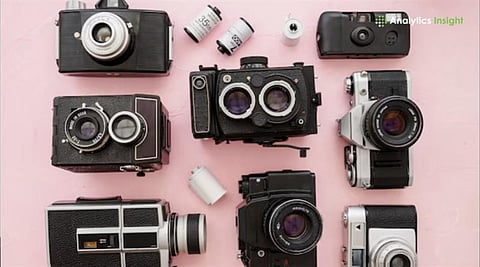

Modular cameras give creators the freedom to customize setups with lenses, microphones, lights, and other accessories for any type of content.
These cameras are versatile and can handle vlogging, live streaming, and cinematic filmmaking with ease.
Many modular cameras combine portability with professional features like 4K video, stabilization, and interchangeable lenses.
Creators benefit from modular cameras that adapt fast, enabling a quick shift from natural handheld recording to stabilized widescreen or real-time streaming. Modern cameras provide incredible features that allow for natural shots from the most complex angles and environmental settings.
A few devices highlight expandability, reliable ecosystems, and professional-level specifications engineered for growth. Let’s take a look at the best modular cameras on the market, along with their features and performance standards.
Modularity drives the Insta360 ONE RS, allowing each recording moment to shape itself through the 4K Boost, 5.7K 360, or 1‑Inch Wide Angle lens. Instead of relying on separate systems, creators pivot between detailed imagery and spherical capture in seconds.
Built with a durable frame, strengthened connectors, and a rapid-release mount, stability becomes a constant factor even through motion-heavy scenes. A 1445 mAh battery keeps the shoots extended, while waterproof protection up to 16 feet ensures its endurance against unpredictable conditions.
Also Read: Best Dash Cameras with Parking Mode for 2025
Dual 1‑inch Leica sensors. 6K 360 resolution. Low‑light clarity. The 1‑Inch 360 Edition integrates professional precision into a modular frame compatible with the RS ecosystem. Upgrading becomes effortless, image grading more flexible, and reframing smoother, making it as dependable for hidden stick travel shots as for full‑scale productions.
For professionals wanting next‑level 360 video, the 1‑Inch 360 Edition integrates dual Leica‑co‑designed 1‑inch sensors into the RS modular platform. It supports up to 6K resolution, providing smooth tonal transitions, richer low‑light textures, and more flexibility in post.
Whether used as a B‑unit or your main camera, GO 3S captures clean, immersive results with effortless invisible selfie stick shots.
Action 2 uses a compact, magnetic module system that lets creators snap on a front touchscreen module for vlogging or a power module for extended runtime, keeping the core camera tiny and wearable for POV and adventure content.
The modular approach enables multiple configurations with ruggedized design for dust, water, and drops, helping streamline set‑ups from body‑mounted clips to handheld framing with dual screens.
PYXIS is a modular box‑style cinema camera designed for flexible rigging. It houses a 36×24 mm full‑frame 6K sensor delivering 13 stops of dynamic range and supports dual CFexpress slots for high‑speed recording.
A USB‑C port allows direct capture to external SSDs for compact workflows. With open‑gate 3:2 shooting and authentic 6:5 anamorphic modes free from cropping, along with customizable side plates, it adapts effortlessly from lightweight gimbal setups to full studio configurations using standard cinema accessories.
KOMODO‑X combines RED’s modular cinema philosophy with a compact Super 35 global‑shutter body that supports 6K up to 80 fps. This includes a locking RF mount for robust lensing and adapters across PL and EF ecosystems.
Enhanced I/O includes 12G‑SDI, USB‑C, professional 5‑pin audio, IP livestreaming, and CFexpress Type B media, making it a flexible nucleus for handheld, gimbal, and multi‑cam live or narrative setups.
Z CAM’s E2‑M4 is a modular box camera with a 4/3 WDR CMOS sensor, 13–15 stops of dynamic range, and support for ProRes RAW over HDMI, designed to be rigged with cages, top handles, and external recorders for creator and indie workflows.
With CFast 2.0 media, 4K recording with high frame‑rate options, and interchangeable mounts in the wider Z CAM ecosystem, it balances affordability with a cinema‑style, rig‑ready form factor.
Also Read: Top Cameras for Product Photography in 2025
From pocketable RS and GO systems to rugged magnetic modules and box‑style cinema brains, these six modular picks cover daily vlogging, POV storytelling, and high‑end production needs without locking creators into a single fixed form.
Awareness of each camera supports an upgrade path that can grow with evolving content goals. Buyers should choose based on shooting style first, then build outward with lenses, modules, media, and methods of input and output.
Modular cameras provide flexibility, versatility, and adaptability. Creators can upgrade or change components as needed, making it easier to produce high-quality videos, live streams, and photos without investing in multiple cameras.
Vloggers, YouTubers, streamers, travel content creators, and filmmakers all benefit. Modular cameras work for beginners who want simplicity and professionals seeking advanced features and customization.
Yes. Many modular cameras support 4K video, in-body stabilization, interchangeable lenses, and advanced audio options. Cameras like the Panasonic Lumix GH7 or Sony ZV-E10 II are suitable for professional filmmaking.
Many modular cameras, such as the DJI Osmo Pocket 3 or Insta360 ONE RS, are compact and lightweight, making them ideal for travel or outdoor shooting while still offering high-quality footage.
Creators can attach lenses, external microphones, LED lights, tripods, gimbals, monitors, and other tools depending on the shooting scenario. This allows full customization to match your content style.
